Analyzing Consumer House Purchase Behavior in Sabah, Malaysia
VerifiedAdded on 2020/11/12
|44
|14558
|327
Report
AI Summary
This report provides a comprehensive analysis of consumer behavior in the context of house purchases within Sabah, Malaysia. It begins with an overview of the study, outlining the background, problem statement, research objectives, questions, significance, scope, limitations, and operational definitions. A detailed literature review explores consumer behavior, house purchase consumer behavior from both global and Malaysian perspectives, and the factors influencing house purchases, including price, income, financing, developer branding, and house features. The report also examines goal-setting theory, the theory of planned behavior, and the stimulus-organism-response model. A conceptual framework and hypotheses are developed to guide the research. The methodology chapter outlines the research design, sampling plan, data collection methods, measurement instruments, and hypothesis testing. The report aims to identify the factors that influence purchasing decisions, analyze real estate trends in Sabah, and determine how these trends affect consumer choices. The findings are expected to assist real estate developers, investors, and government agencies in making informed decisions and improving the housing market in Sabah.
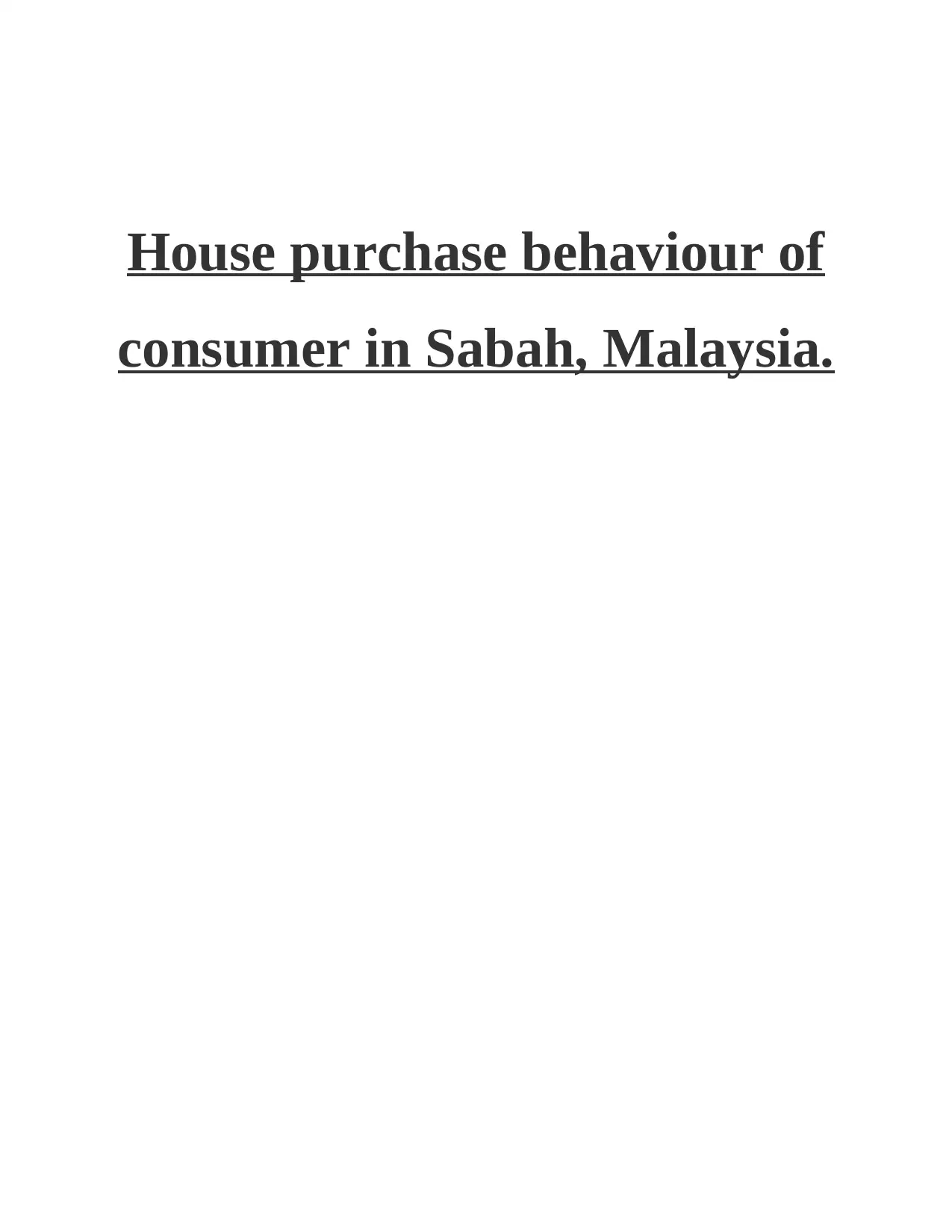
House purchase behaviour of
consumer in Sabah, Malaysia.
consumer in Sabah, Malaysia.
Paraphrase This Document
Need a fresh take? Get an instant paraphrase of this document with our AI Paraphraser
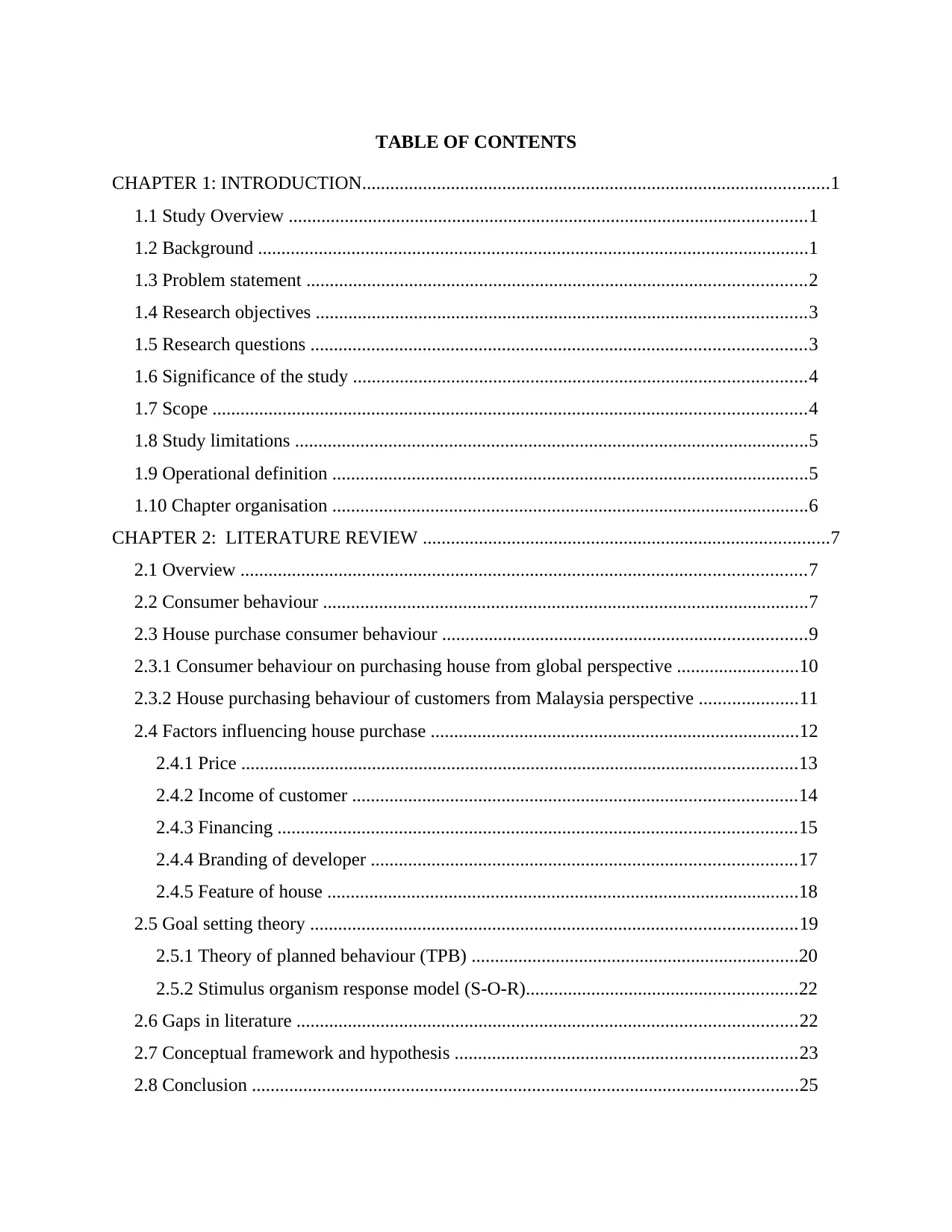
TABLE OF CONTENTS
CHAPTER 1: INTRODUCTION....................................................................................................1
1.1 Study Overview ...............................................................................................................1
1.2 Background ......................................................................................................................1
1.3 Problem statement ...........................................................................................................2
1.4 Research objectives .........................................................................................................3
1.5 Research questions ..........................................................................................................3
1.6 Significance of the study .................................................................................................4
1.7 Scope ...............................................................................................................................4
1.8 Study limitations ..............................................................................................................5
1.9 Operational definition ......................................................................................................5
1.10 Chapter organisation ......................................................................................................6
CHAPTER 2: LITERATURE REVIEW .......................................................................................7
2.1 Overview .........................................................................................................................7
2.2 Consumer behaviour ........................................................................................................7
2.3 House purchase consumer behaviour ..............................................................................9
2.3.1 Consumer behaviour on purchasing house from global perspective ..........................10
2.3.2 House purchasing behaviour of customers from Malaysia perspective .....................11
2.4 Factors influencing house purchase ...............................................................................12
2.4.1 Price .......................................................................................................................13
2.4.2 Income of customer ...............................................................................................14
2.4.3 Financing ...............................................................................................................15
2.4.4 Branding of developer ...........................................................................................17
2.4.5 Feature of house .....................................................................................................18
2.5 Goal setting theory ........................................................................................................19
2.5.1 Theory of planned behaviour (TPB) ......................................................................20
2.5.2 Stimulus organism response model (S-O-R)..........................................................22
2.6 Gaps in literature ...........................................................................................................22
2.7 Conceptual framework and hypothesis .........................................................................23
2.8 Conclusion .....................................................................................................................25
CHAPTER 1: INTRODUCTION....................................................................................................1
1.1 Study Overview ...............................................................................................................1
1.2 Background ......................................................................................................................1
1.3 Problem statement ...........................................................................................................2
1.4 Research objectives .........................................................................................................3
1.5 Research questions ..........................................................................................................3
1.6 Significance of the study .................................................................................................4
1.7 Scope ...............................................................................................................................4
1.8 Study limitations ..............................................................................................................5
1.9 Operational definition ......................................................................................................5
1.10 Chapter organisation ......................................................................................................6
CHAPTER 2: LITERATURE REVIEW .......................................................................................7
2.1 Overview .........................................................................................................................7
2.2 Consumer behaviour ........................................................................................................7
2.3 House purchase consumer behaviour ..............................................................................9
2.3.1 Consumer behaviour on purchasing house from global perspective ..........................10
2.3.2 House purchasing behaviour of customers from Malaysia perspective .....................11
2.4 Factors influencing house purchase ...............................................................................12
2.4.1 Price .......................................................................................................................13
2.4.2 Income of customer ...............................................................................................14
2.4.3 Financing ...............................................................................................................15
2.4.4 Branding of developer ...........................................................................................17
2.4.5 Feature of house .....................................................................................................18
2.5 Goal setting theory ........................................................................................................19
2.5.1 Theory of planned behaviour (TPB) ......................................................................20
2.5.2 Stimulus organism response model (S-O-R)..........................................................22
2.6 Gaps in literature ...........................................................................................................22
2.7 Conceptual framework and hypothesis .........................................................................23
2.8 Conclusion .....................................................................................................................25
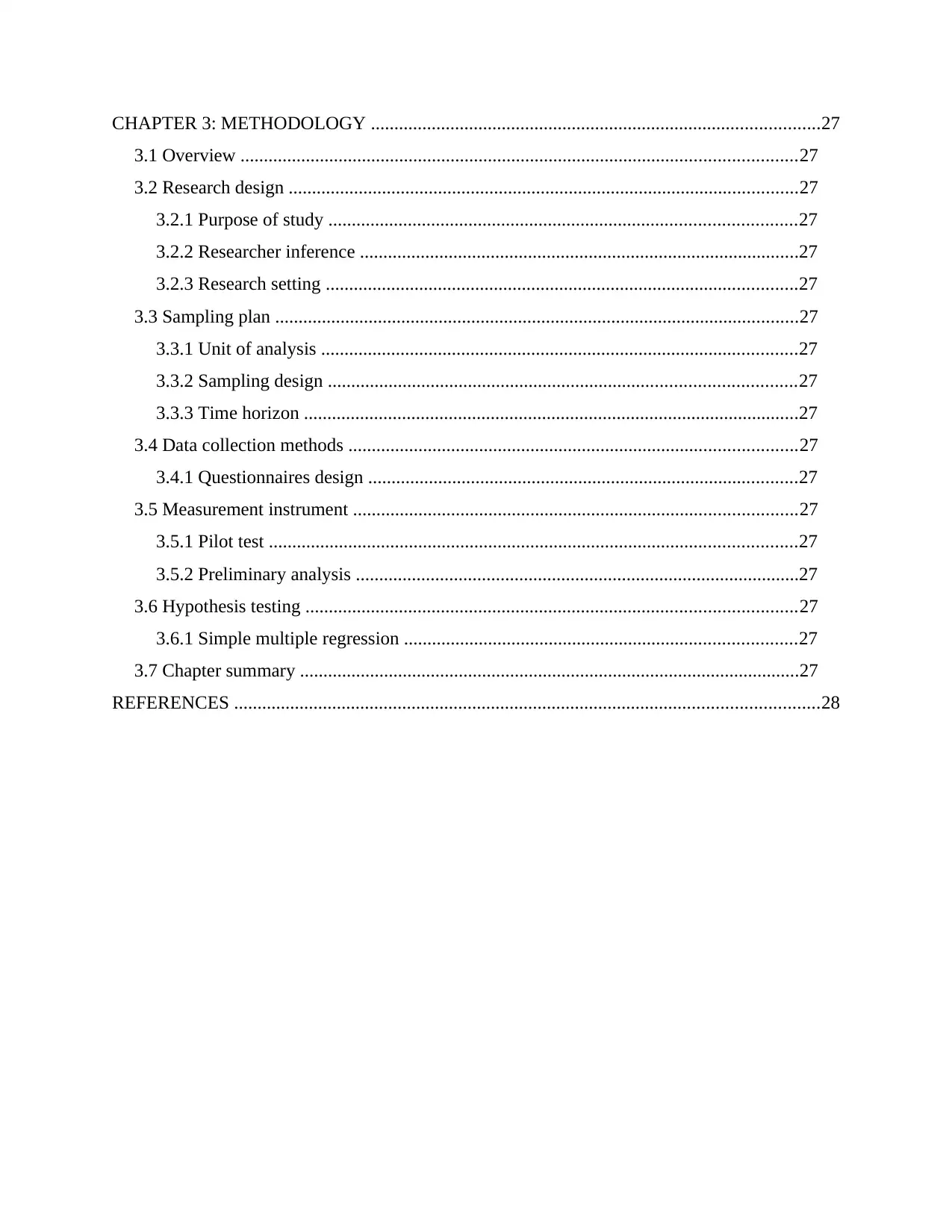
CHAPTER 3: METHODOLOGY ................................................................................................27
3.1 Overview .......................................................................................................................27
3.2 Research design .............................................................................................................27
3.2.1 Purpose of study ....................................................................................................27
3.2.2 Researcher inference ..............................................................................................27
3.2.3 Research setting .....................................................................................................27
3.3 Sampling plan ................................................................................................................27
3.3.1 Unit of analysis ......................................................................................................27
3.3.2 Sampling design ....................................................................................................27
3.3.3 Time horizon ..........................................................................................................27
3.4 Data collection methods ................................................................................................27
3.4.1 Questionnaires design ............................................................................................27
3.5 Measurement instrument ...............................................................................................27
3.5.1 Pilot test .................................................................................................................27
3.5.2 Preliminary analysis ...............................................................................................27
3.6 Hypothesis testing .........................................................................................................27
3.6.1 Simple multiple regression ....................................................................................27
3.7 Chapter summary ...........................................................................................................27
REFERENCES .............................................................................................................................28
3.1 Overview .......................................................................................................................27
3.2 Research design .............................................................................................................27
3.2.1 Purpose of study ....................................................................................................27
3.2.2 Researcher inference ..............................................................................................27
3.2.3 Research setting .....................................................................................................27
3.3 Sampling plan ................................................................................................................27
3.3.1 Unit of analysis ......................................................................................................27
3.3.2 Sampling design ....................................................................................................27
3.3.3 Time horizon ..........................................................................................................27
3.4 Data collection methods ................................................................................................27
3.4.1 Questionnaires design ............................................................................................27
3.5 Measurement instrument ...............................................................................................27
3.5.1 Pilot test .................................................................................................................27
3.5.2 Preliminary analysis ...............................................................................................27
3.6 Hypothesis testing .........................................................................................................27
3.6.1 Simple multiple regression ....................................................................................27
3.7 Chapter summary ...........................................................................................................27
REFERENCES .............................................................................................................................28
⊘ This is a preview!⊘
Do you want full access?
Subscribe today to unlock all pages.

Trusted by 1+ million students worldwide
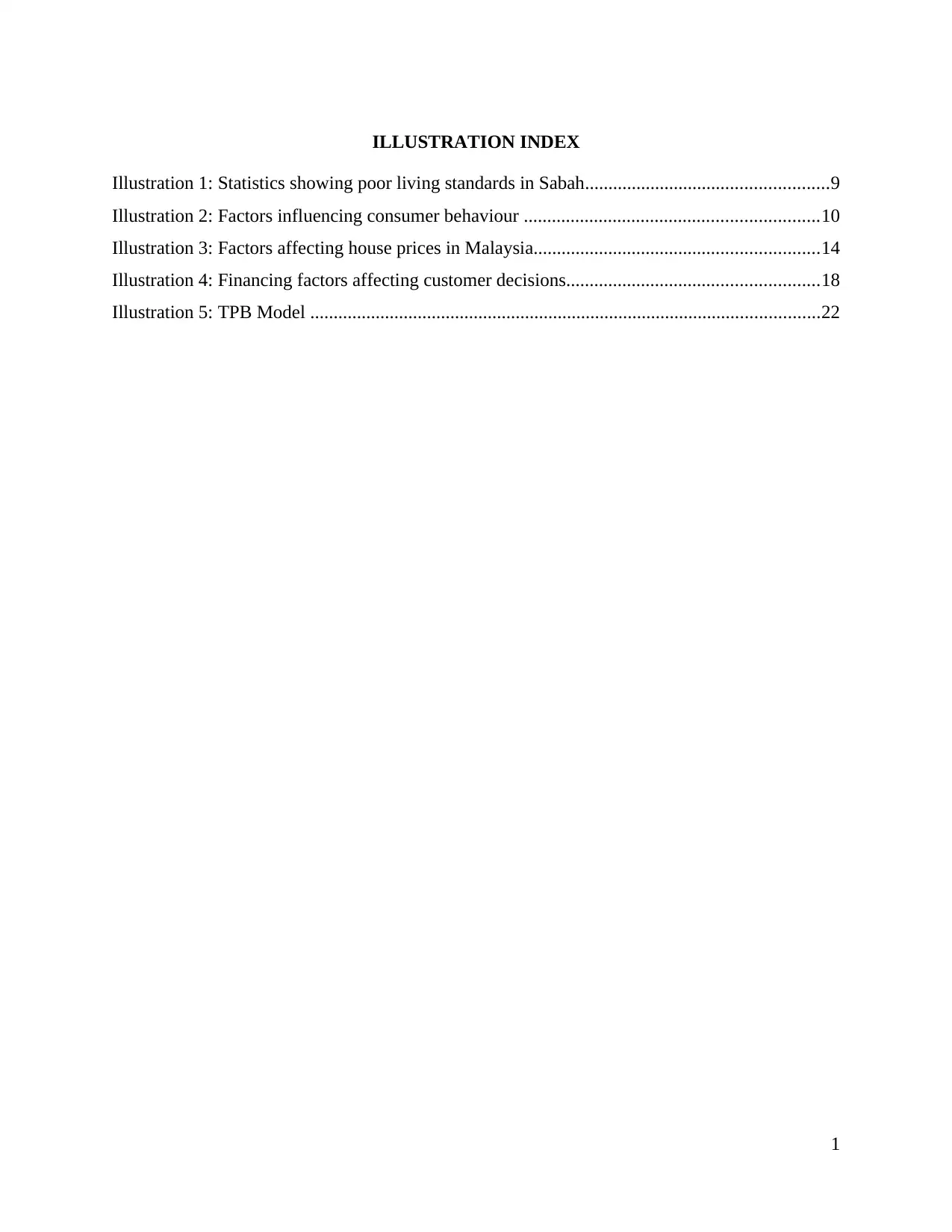
ILLUSTRATION INDEX
Illustration 1: Statistics showing poor living standards in Sabah....................................................9
Illustration 2: Factors influencing consumer behaviour ...............................................................10
Illustration 3: Factors affecting house prices in Malaysia.............................................................14
Illustration 4: Financing factors affecting customer decisions......................................................18
Illustration 5: TPB Model .............................................................................................................22
1
Illustration 1: Statistics showing poor living standards in Sabah....................................................9
Illustration 2: Factors influencing consumer behaviour ...............................................................10
Illustration 3: Factors affecting house prices in Malaysia.............................................................14
Illustration 4: Financing factors affecting customer decisions......................................................18
Illustration 5: TPB Model .............................................................................................................22
1
Paraphrase This Document
Need a fresh take? Get an instant paraphrase of this document with our AI Paraphraser
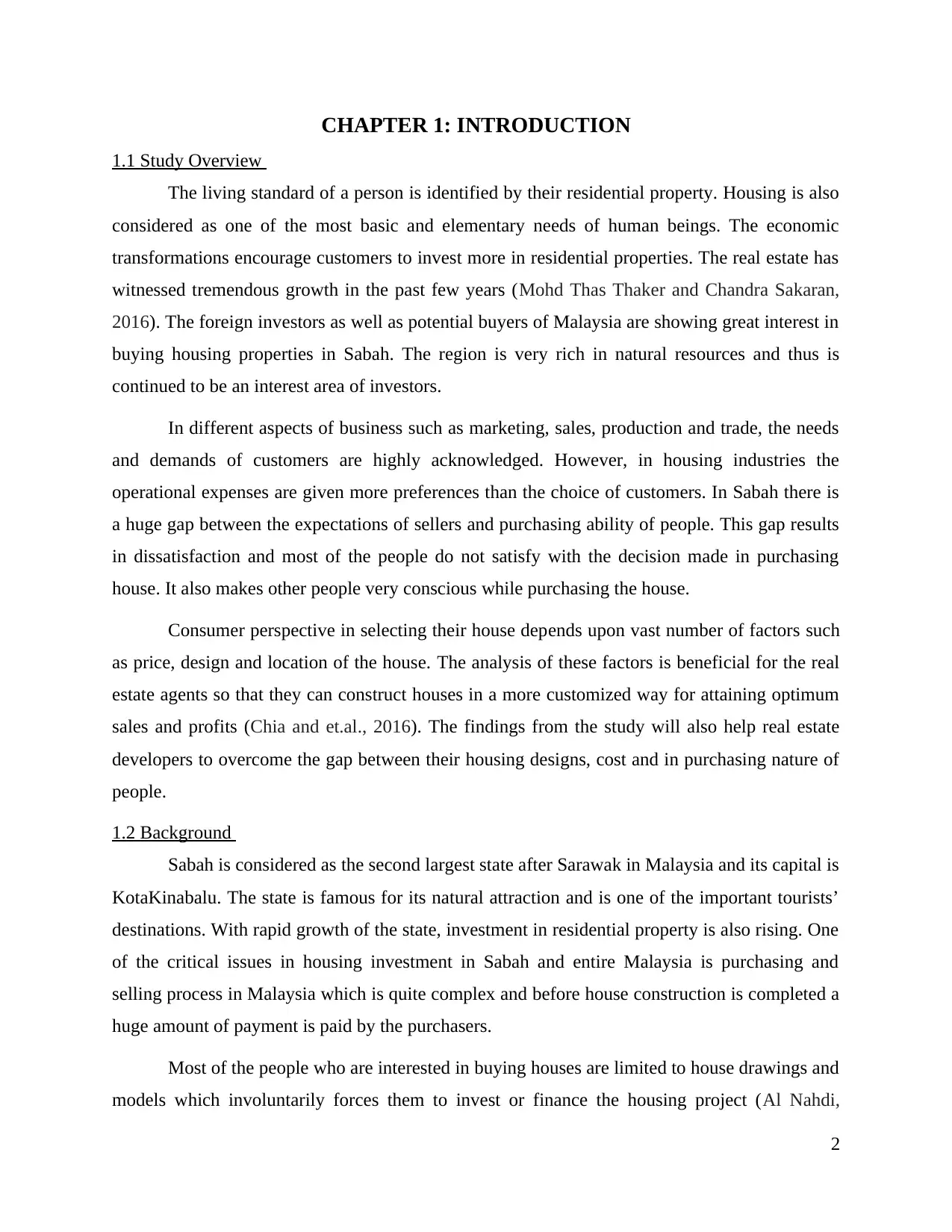
CHAPTER 1: INTRODUCTION
1.1 Study Overview
The living standard of a person is identified by their residential property. Housing is also
considered as one of the most basic and elementary needs of human beings. The economic
transformations encourage customers to invest more in residential properties. The real estate has
witnessed tremendous growth in the past few years (Mohd Thas Thaker and Chandra Sakaran,
2016). The foreign investors as well as potential buyers of Malaysia are showing great interest in
buying housing properties in Sabah. The region is very rich in natural resources and thus is
continued to be an interest area of investors.
In different aspects of business such as marketing, sales, production and trade, the needs
and demands of customers are highly acknowledged. However, in housing industries the
operational expenses are given more preferences than the choice of customers. In Sabah there is
a huge gap between the expectations of sellers and purchasing ability of people. This gap results
in dissatisfaction and most of the people do not satisfy with the decision made in purchasing
house. It also makes other people very conscious while purchasing the house.
Consumer perspective in selecting their house depends upon vast number of factors such
as price, design and location of the house. The analysis of these factors is beneficial for the real
estate agents so that they can construct houses in a more customized way for attaining optimum
sales and profits (Chia and et.al., 2016). The findings from the study will also help real estate
developers to overcome the gap between their housing designs, cost and in purchasing nature of
people.
1.2 Background
Sabah is considered as the second largest state after Sarawak in Malaysia and its capital is
KotaKinabalu. The state is famous for its natural attraction and is one of the important tourists’
destinations. With rapid growth of the state, investment in residential property is also rising. One
of the critical issues in housing investment in Sabah and entire Malaysia is purchasing and
selling process in Malaysia which is quite complex and before house construction is completed a
huge amount of payment is paid by the purchasers.
Most of the people who are interested in buying houses are limited to house drawings and
models which involuntarily forces them to invest or finance the housing project (Al Nahdi,
2
1.1 Study Overview
The living standard of a person is identified by their residential property. Housing is also
considered as one of the most basic and elementary needs of human beings. The economic
transformations encourage customers to invest more in residential properties. The real estate has
witnessed tremendous growth in the past few years (Mohd Thas Thaker and Chandra Sakaran,
2016). The foreign investors as well as potential buyers of Malaysia are showing great interest in
buying housing properties in Sabah. The region is very rich in natural resources and thus is
continued to be an interest area of investors.
In different aspects of business such as marketing, sales, production and trade, the needs
and demands of customers are highly acknowledged. However, in housing industries the
operational expenses are given more preferences than the choice of customers. In Sabah there is
a huge gap between the expectations of sellers and purchasing ability of people. This gap results
in dissatisfaction and most of the people do not satisfy with the decision made in purchasing
house. It also makes other people very conscious while purchasing the house.
Consumer perspective in selecting their house depends upon vast number of factors such
as price, design and location of the house. The analysis of these factors is beneficial for the real
estate agents so that they can construct houses in a more customized way for attaining optimum
sales and profits (Chia and et.al., 2016). The findings from the study will also help real estate
developers to overcome the gap between their housing designs, cost and in purchasing nature of
people.
1.2 Background
Sabah is considered as the second largest state after Sarawak in Malaysia and its capital is
KotaKinabalu. The state is famous for its natural attraction and is one of the important tourists’
destinations. With rapid growth of the state, investment in residential property is also rising. One
of the critical issues in housing investment in Sabah and entire Malaysia is purchasing and
selling process in Malaysia which is quite complex and before house construction is completed a
huge amount of payment is paid by the purchasers.
Most of the people who are interested in buying houses are limited to house drawings and
models which involuntarily forces them to invest or finance the housing project (Al Nahdi,
2
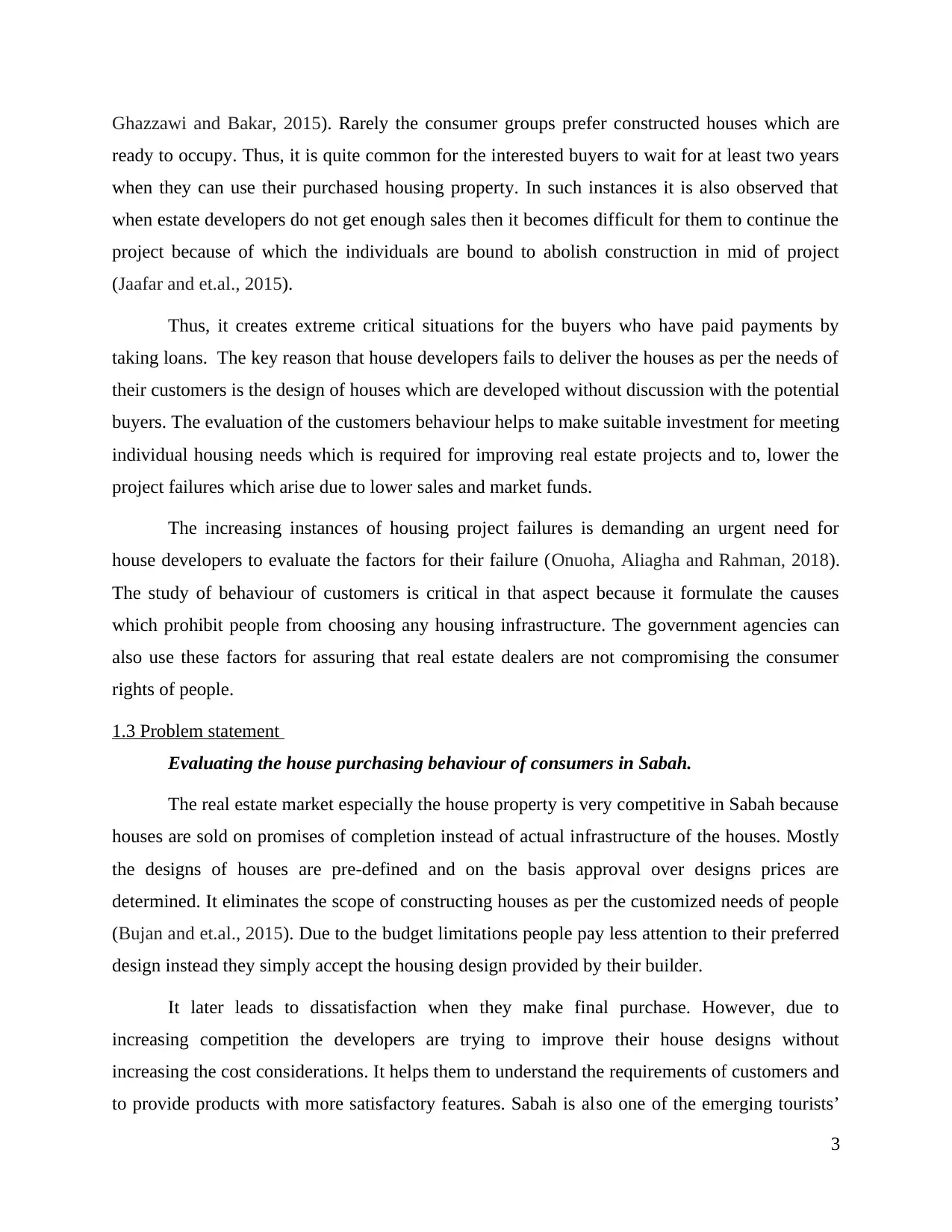
Ghazzawi and Bakar, 2015). Rarely the consumer groups prefer constructed houses which are
ready to occupy. Thus, it is quite common for the interested buyers to wait for at least two years
when they can use their purchased housing property. In such instances it is also observed that
when estate developers do not get enough sales then it becomes difficult for them to continue the
project because of which the individuals are bound to abolish construction in mid of project
(Jaafar and et.al., 2015).
Thus, it creates extreme critical situations for the buyers who have paid payments by
taking loans. The key reason that house developers fails to deliver the houses as per the needs of
their customers is the design of houses which are developed without discussion with the potential
buyers. The evaluation of the customers behaviour helps to make suitable investment for meeting
individual housing needs which is required for improving real estate projects and to, lower the
project failures which arise due to lower sales and market funds.
The increasing instances of housing project failures is demanding an urgent need for
house developers to evaluate the factors for their failure (Onuoha, Aliagha and Rahman, 2018).
The study of behaviour of customers is critical in that aspect because it formulate the causes
which prohibit people from choosing any housing infrastructure. The government agencies can
also use these factors for assuring that real estate dealers are not compromising the consumer
rights of people.
1.3 Problem statement
Evaluating the house purchasing behaviour of consumers in Sabah.
The real estate market especially the house property is very competitive in Sabah because
houses are sold on promises of completion instead of actual infrastructure of the houses. Mostly
the designs of houses are pre-defined and on the basis approval over designs prices are
determined. It eliminates the scope of constructing houses as per the customized needs of people
(Bujan and et.al., 2015). Due to the budget limitations people pay less attention to their preferred
design instead they simply accept the housing design provided by their builder.
It later leads to dissatisfaction when they make final purchase. However, due to
increasing competition the developers are trying to improve their house designs without
increasing the cost considerations. It helps them to understand the requirements of customers and
to provide products with more satisfactory features. Sabah is also one of the emerging tourists’
3
ready to occupy. Thus, it is quite common for the interested buyers to wait for at least two years
when they can use their purchased housing property. In such instances it is also observed that
when estate developers do not get enough sales then it becomes difficult for them to continue the
project because of which the individuals are bound to abolish construction in mid of project
(Jaafar and et.al., 2015).
Thus, it creates extreme critical situations for the buyers who have paid payments by
taking loans. The key reason that house developers fails to deliver the houses as per the needs of
their customers is the design of houses which are developed without discussion with the potential
buyers. The evaluation of the customers behaviour helps to make suitable investment for meeting
individual housing needs which is required for improving real estate projects and to, lower the
project failures which arise due to lower sales and market funds.
The increasing instances of housing project failures is demanding an urgent need for
house developers to evaluate the factors for their failure (Onuoha, Aliagha and Rahman, 2018).
The study of behaviour of customers is critical in that aspect because it formulate the causes
which prohibit people from choosing any housing infrastructure. The government agencies can
also use these factors for assuring that real estate dealers are not compromising the consumer
rights of people.
1.3 Problem statement
Evaluating the house purchasing behaviour of consumers in Sabah.
The real estate market especially the house property is very competitive in Sabah because
houses are sold on promises of completion instead of actual infrastructure of the houses. Mostly
the designs of houses are pre-defined and on the basis approval over designs prices are
determined. It eliminates the scope of constructing houses as per the customized needs of people
(Bujan and et.al., 2015). Due to the budget limitations people pay less attention to their preferred
design instead they simply accept the housing design provided by their builder.
It later leads to dissatisfaction when they make final purchase. However, due to
increasing competition the developers are trying to improve their house designs without
increasing the cost considerations. It helps them to understand the requirements of customers and
to provide products with more satisfactory features. Sabah is also one of the emerging tourists’
3
⊘ This is a preview!⊘
Do you want full access?
Subscribe today to unlock all pages.

Trusted by 1+ million students worldwide
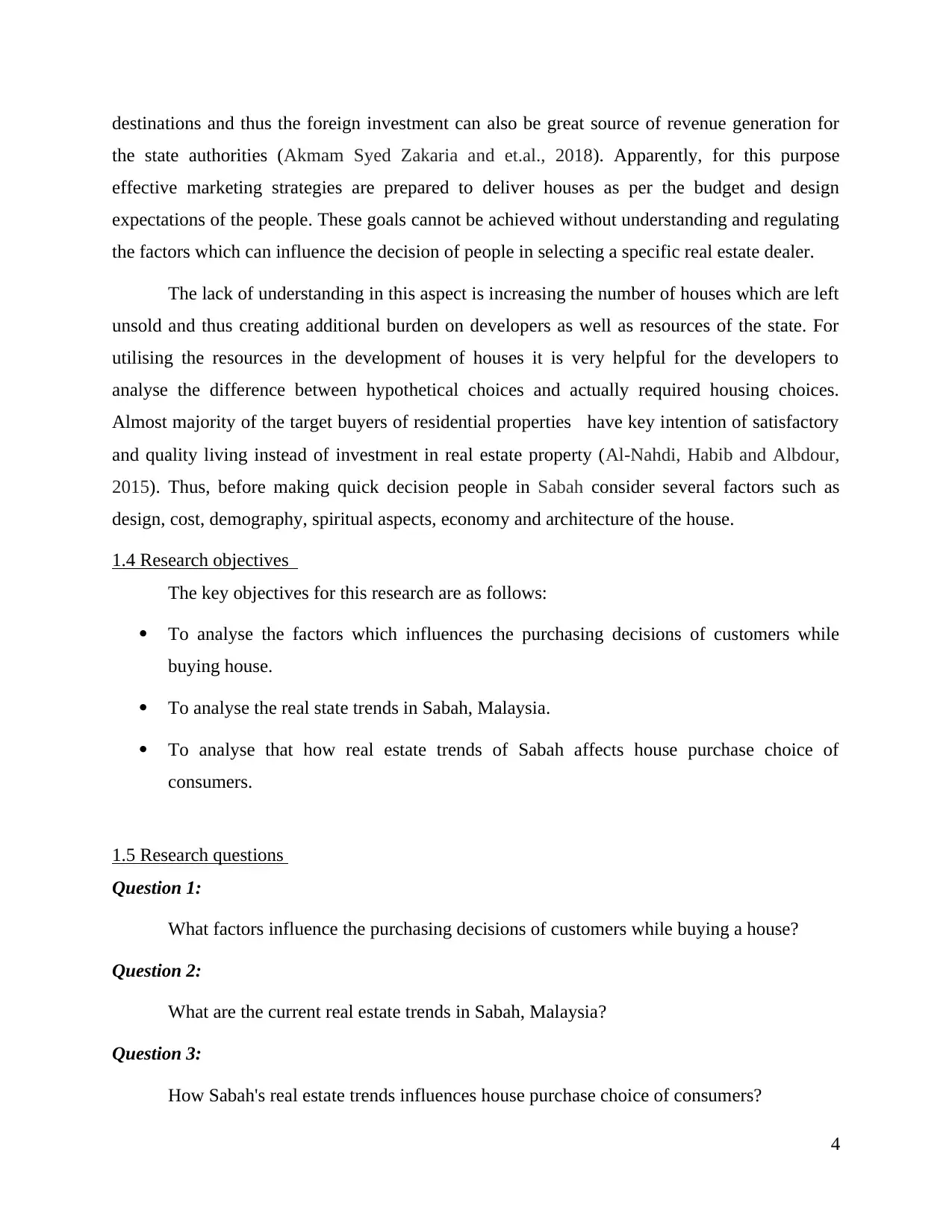
destinations and thus the foreign investment can also be great source of revenue generation for
the state authorities (Akmam Syed Zakaria and et.al., 2018). Apparently, for this purpose
effective marketing strategies are prepared to deliver houses as per the budget and design
expectations of the people. These goals cannot be achieved without understanding and regulating
the factors which can influence the decision of people in selecting a specific real estate dealer.
The lack of understanding in this aspect is increasing the number of houses which are left
unsold and thus creating additional burden on developers as well as resources of the state. For
utilising the resources in the development of houses it is very helpful for the developers to
analyse the difference between hypothetical choices and actually required housing choices.
Almost majority of the target buyers of residential properties have key intention of satisfactory
and quality living instead of investment in real estate property (Al-Nahdi, Habib and Albdour,
2015). Thus, before making quick decision people in Sabah consider several factors such as
design, cost, demography, spiritual aspects, economy and architecture of the house.
1.4 Research objectives
The key objectives for this research are as follows:
To analyse the factors which influences the purchasing decisions of customers while
buying house.
To analyse the real state trends in Sabah, Malaysia.
To analyse that how real estate trends of Sabah affects house purchase choice of
consumers.
1.5 Research questions
Question 1:
What factors influence the purchasing decisions of customers while buying a house?
Question 2:
What are the current real estate trends in Sabah, Malaysia?
Question 3:
How Sabah's real estate trends influences house purchase choice of consumers?
4
the state authorities (Akmam Syed Zakaria and et.al., 2018). Apparently, for this purpose
effective marketing strategies are prepared to deliver houses as per the budget and design
expectations of the people. These goals cannot be achieved without understanding and regulating
the factors which can influence the decision of people in selecting a specific real estate dealer.
The lack of understanding in this aspect is increasing the number of houses which are left
unsold and thus creating additional burden on developers as well as resources of the state. For
utilising the resources in the development of houses it is very helpful for the developers to
analyse the difference between hypothetical choices and actually required housing choices.
Almost majority of the target buyers of residential properties have key intention of satisfactory
and quality living instead of investment in real estate property (Al-Nahdi, Habib and Albdour,
2015). Thus, before making quick decision people in Sabah consider several factors such as
design, cost, demography, spiritual aspects, economy and architecture of the house.
1.4 Research objectives
The key objectives for this research are as follows:
To analyse the factors which influences the purchasing decisions of customers while
buying house.
To analyse the real state trends in Sabah, Malaysia.
To analyse that how real estate trends of Sabah affects house purchase choice of
consumers.
1.5 Research questions
Question 1:
What factors influence the purchasing decisions of customers while buying a house?
Question 2:
What are the current real estate trends in Sabah, Malaysia?
Question 3:
How Sabah's real estate trends influences house purchase choice of consumers?
4
Paraphrase This Document
Need a fresh take? Get an instant paraphrase of this document with our AI Paraphraser
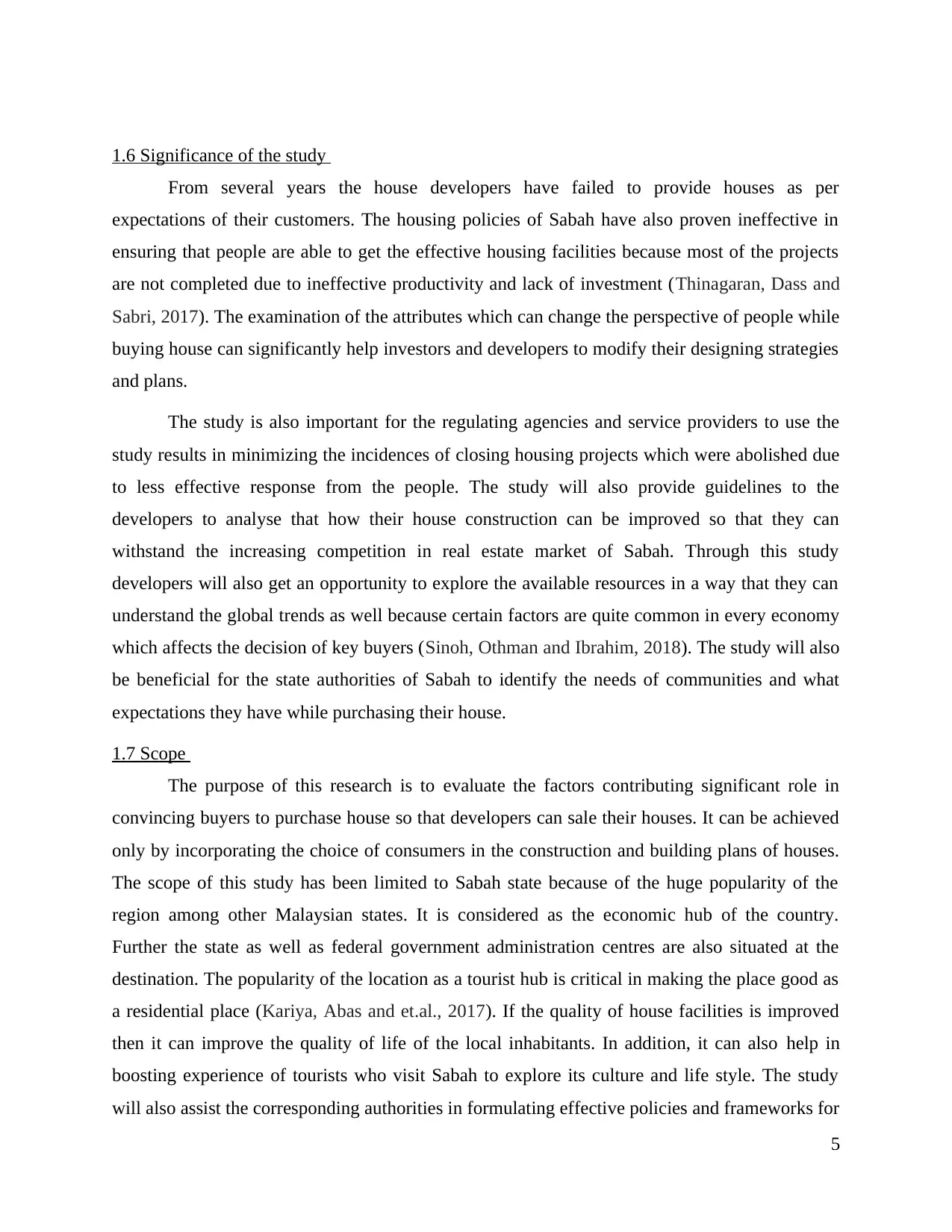
1.6 Significance of the study
From several years the house developers have failed to provide houses as per
expectations of their customers. The housing policies of Sabah have also proven ineffective in
ensuring that people are able to get the effective housing facilities because most of the projects
are not completed due to ineffective productivity and lack of investment (Thinagaran, Dass and
Sabri, 2017). The examination of the attributes which can change the perspective of people while
buying house can significantly help investors and developers to modify their designing strategies
and plans.
The study is also important for the regulating agencies and service providers to use the
study results in minimizing the incidences of closing housing projects which were abolished due
to less effective response from the people. The study will also provide guidelines to the
developers to analyse that how their house construction can be improved so that they can
withstand the increasing competition in real estate market of Sabah. Through this study
developers will also get an opportunity to explore the available resources in a way that they can
understand the global trends as well because certain factors are quite common in every economy
which affects the decision of key buyers (Sinoh, Othman and Ibrahim, 2018). The study will also
be beneficial for the state authorities of Sabah to identify the needs of communities and what
expectations they have while purchasing their house.
1.7 Scope
The purpose of this research is to evaluate the factors contributing significant role in
convincing buyers to purchase house so that developers can sale their houses. It can be achieved
only by incorporating the choice of consumers in the construction and building plans of houses.
The scope of this study has been limited to Sabah state because of the huge popularity of the
region among other Malaysian states. It is considered as the economic hub of the country.
Further the state as well as federal government administration centres are also situated at the
destination. The popularity of the location as a tourist hub is critical in making the place good as
a residential place (Kariya, Abas and et.al., 2017). If the quality of house facilities is improved
then it can improve the quality of life of the local inhabitants. In addition, it can also help in
boosting experience of tourists who visit Sabah to explore its culture and life style. The study
will also assist the corresponding authorities in formulating effective policies and frameworks for
5
From several years the house developers have failed to provide houses as per
expectations of their customers. The housing policies of Sabah have also proven ineffective in
ensuring that people are able to get the effective housing facilities because most of the projects
are not completed due to ineffective productivity and lack of investment (Thinagaran, Dass and
Sabri, 2017). The examination of the attributes which can change the perspective of people while
buying house can significantly help investors and developers to modify their designing strategies
and plans.
The study is also important for the regulating agencies and service providers to use the
study results in minimizing the incidences of closing housing projects which were abolished due
to less effective response from the people. The study will also provide guidelines to the
developers to analyse that how their house construction can be improved so that they can
withstand the increasing competition in real estate market of Sabah. Through this study
developers will also get an opportunity to explore the available resources in a way that they can
understand the global trends as well because certain factors are quite common in every economy
which affects the decision of key buyers (Sinoh, Othman and Ibrahim, 2018). The study will also
be beneficial for the state authorities of Sabah to identify the needs of communities and what
expectations they have while purchasing their house.
1.7 Scope
The purpose of this research is to evaluate the factors contributing significant role in
convincing buyers to purchase house so that developers can sale their houses. It can be achieved
only by incorporating the choice of consumers in the construction and building plans of houses.
The scope of this study has been limited to Sabah state because of the huge popularity of the
region among other Malaysian states. It is considered as the economic hub of the country.
Further the state as well as federal government administration centres are also situated at the
destination. The popularity of the location as a tourist hub is critical in making the place good as
a residential place (Kariya, Abas and et.al., 2017). If the quality of house facilities is improved
then it can improve the quality of life of the local inhabitants. In addition, it can also help in
boosting experience of tourists who visit Sabah to explore its culture and life style. The study
will also assist the corresponding authorities in formulating effective policies and frameworks for
5
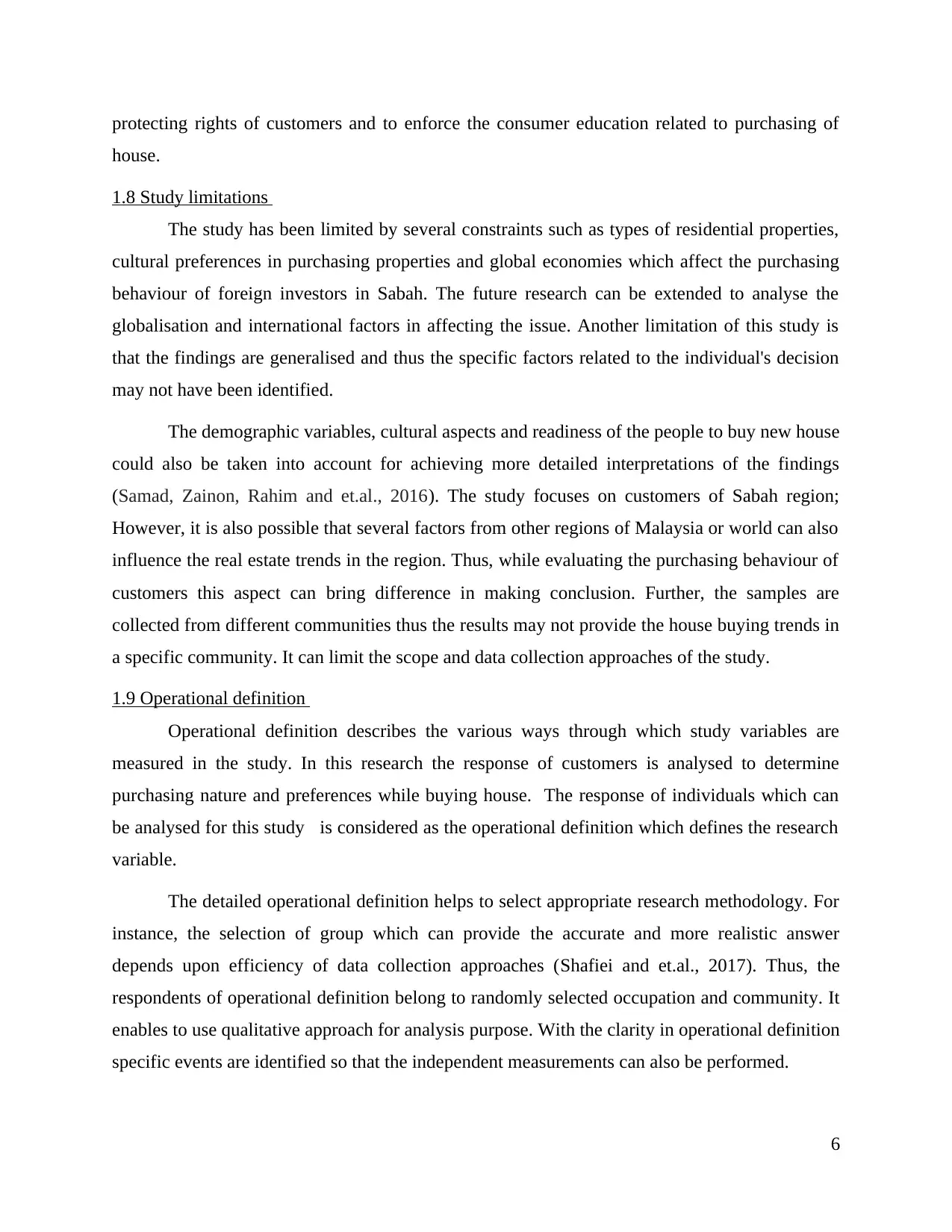
protecting rights of customers and to enforce the consumer education related to purchasing of
house.
1.8 Study limitations
The study has been limited by several constraints such as types of residential properties,
cultural preferences in purchasing properties and global economies which affect the purchasing
behaviour of foreign investors in Sabah. The future research can be extended to analyse the
globalisation and international factors in affecting the issue. Another limitation of this study is
that the findings are generalised and thus the specific factors related to the individual's decision
may not have been identified.
The demographic variables, cultural aspects and readiness of the people to buy new house
could also be taken into account for achieving more detailed interpretations of the findings
(Samad, Zainon, Rahim and et.al., 2016). The study focuses on customers of Sabah region;
However, it is also possible that several factors from other regions of Malaysia or world can also
influence the real estate trends in the region. Thus, while evaluating the purchasing behaviour of
customers this aspect can bring difference in making conclusion. Further, the samples are
collected from different communities thus the results may not provide the house buying trends in
a specific community. It can limit the scope and data collection approaches of the study.
1.9 Operational definition
Operational definition describes the various ways through which study variables are
measured in the study. In this research the response of customers is analysed to determine
purchasing nature and preferences while buying house. The response of individuals which can
be analysed for this study is considered as the operational definition which defines the research
variable.
The detailed operational definition helps to select appropriate research methodology. For
instance, the selection of group which can provide the accurate and more realistic answer
depends upon efficiency of data collection approaches (Shafiei and et.al., 2017). Thus, the
respondents of operational definition belong to randomly selected occupation and community. It
enables to use qualitative approach for analysis purpose. With the clarity in operational definition
specific events are identified so that the independent measurements can also be performed.
6
house.
1.8 Study limitations
The study has been limited by several constraints such as types of residential properties,
cultural preferences in purchasing properties and global economies which affect the purchasing
behaviour of foreign investors in Sabah. The future research can be extended to analyse the
globalisation and international factors in affecting the issue. Another limitation of this study is
that the findings are generalised and thus the specific factors related to the individual's decision
may not have been identified.
The demographic variables, cultural aspects and readiness of the people to buy new house
could also be taken into account for achieving more detailed interpretations of the findings
(Samad, Zainon, Rahim and et.al., 2016). The study focuses on customers of Sabah region;
However, it is also possible that several factors from other regions of Malaysia or world can also
influence the real estate trends in the region. Thus, while evaluating the purchasing behaviour of
customers this aspect can bring difference in making conclusion. Further, the samples are
collected from different communities thus the results may not provide the house buying trends in
a specific community. It can limit the scope and data collection approaches of the study.
1.9 Operational definition
Operational definition describes the various ways through which study variables are
measured in the study. In this research the response of customers is analysed to determine
purchasing nature and preferences while buying house. The response of individuals which can
be analysed for this study is considered as the operational definition which defines the research
variable.
The detailed operational definition helps to select appropriate research methodology. For
instance, the selection of group which can provide the accurate and more realistic answer
depends upon efficiency of data collection approaches (Shafiei and et.al., 2017). Thus, the
respondents of operational definition belong to randomly selected occupation and community. It
enables to use qualitative approach for analysis purpose. With the clarity in operational definition
specific events are identified so that the independent measurements can also be performed.
6
⊘ This is a preview!⊘
Do you want full access?
Subscribe today to unlock all pages.

Trusted by 1+ million students worldwide
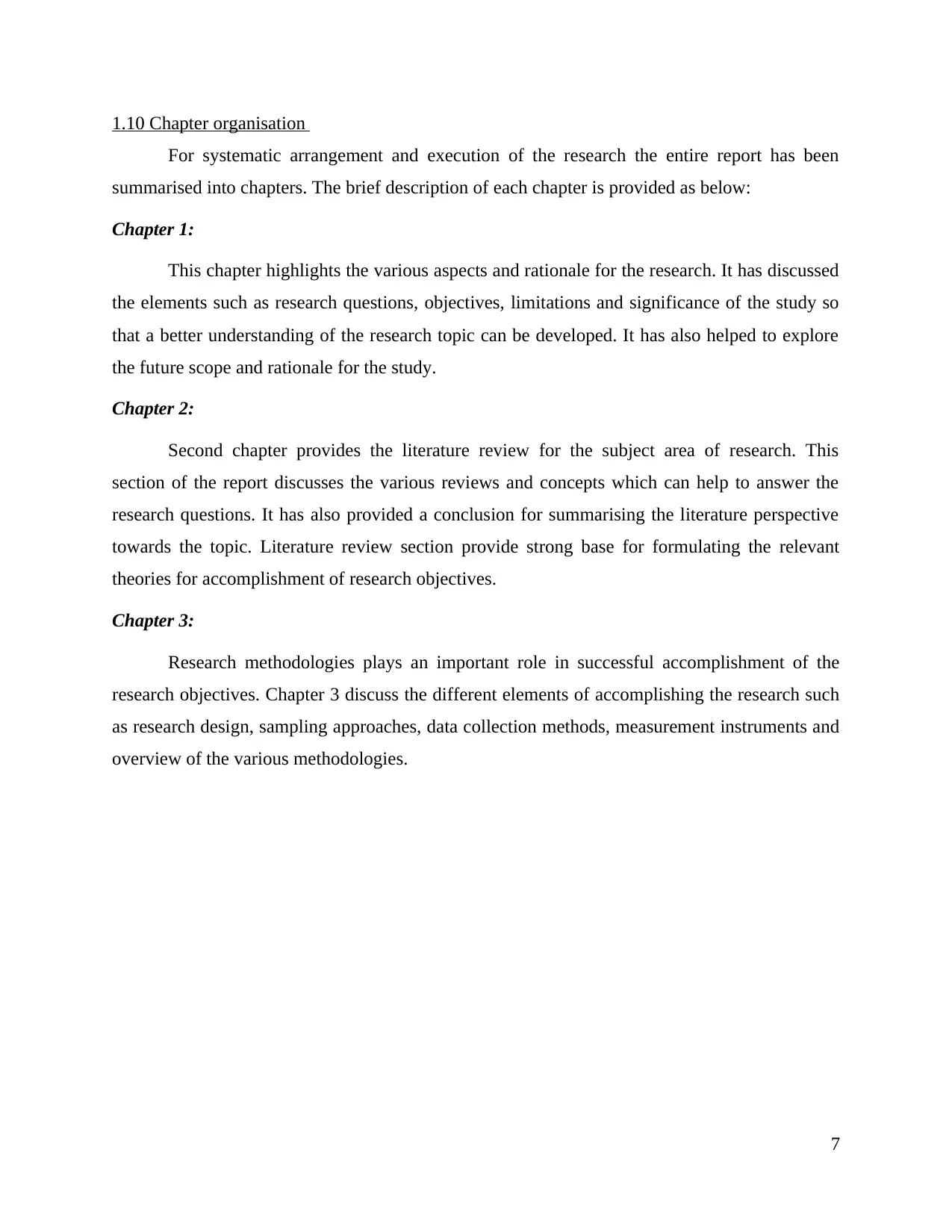
1.10 Chapter organisation
For systematic arrangement and execution of the research the entire report has been
summarised into chapters. The brief description of each chapter is provided as below:
Chapter 1:
This chapter highlights the various aspects and rationale for the research. It has discussed
the elements such as research questions, objectives, limitations and significance of the study so
that a better understanding of the research topic can be developed. It has also helped to explore
the future scope and rationale for the study.
Chapter 2:
Second chapter provides the literature review for the subject area of research. This
section of the report discusses the various reviews and concepts which can help to answer the
research questions. It has also provided a conclusion for summarising the literature perspective
towards the topic. Literature review section provide strong base for formulating the relevant
theories for accomplishment of research objectives.
Chapter 3:
Research methodologies plays an important role in successful accomplishment of the
research objectives. Chapter 3 discuss the different elements of accomplishing the research such
as research design, sampling approaches, data collection methods, measurement instruments and
overview of the various methodologies.
7
For systematic arrangement and execution of the research the entire report has been
summarised into chapters. The brief description of each chapter is provided as below:
Chapter 1:
This chapter highlights the various aspects and rationale for the research. It has discussed
the elements such as research questions, objectives, limitations and significance of the study so
that a better understanding of the research topic can be developed. It has also helped to explore
the future scope and rationale for the study.
Chapter 2:
Second chapter provides the literature review for the subject area of research. This
section of the report discusses the various reviews and concepts which can help to answer the
research questions. It has also provided a conclusion for summarising the literature perspective
towards the topic. Literature review section provide strong base for formulating the relevant
theories for accomplishment of research objectives.
Chapter 3:
Research methodologies plays an important role in successful accomplishment of the
research objectives. Chapter 3 discuss the different elements of accomplishing the research such
as research design, sampling approaches, data collection methods, measurement instruments and
overview of the various methodologies.
7
Paraphrase This Document
Need a fresh take? Get an instant paraphrase of this document with our AI Paraphraser

CHAPTER 2: LITERATURE REVIEW
2.1 Overview
According to Solomon and et.al., (2017) housing requirements of people satisfy their
safety and security needs. The understanding of consumer behaviour helps housing developers to
make better decisions and to deliver more effective house solutions to people. However, there
have been vast number of attributes associated with the purchasing of house. The factors such as
pricing, types and need of house, family and cultural values, economic stability and social status
often influences the buying decisions. The key reason due to which people pay show extreme
concern and caution in purchasing house is that along with satisfying the lifelong needs of people
house is also associated with the reflection of social status.
In the same context Bhutta, Dokko and Shan, (2017) stated that owing a house can mean
different for different individuals. For instance, for some people it can be just a method of
investing in real estate while for others it can be symbol of their prestigious position in society.
Similarly, for the majority of people it is the medium to fulfil their safety needs.
Hoonsopon and Puriwat, (2016) stated that purchasing behaviour of people is not only
affected by the regional and personal factors instead the global parameters also influence the
deals in real estate. Various theories and models such as planned behaviour theory and organism
response model helps service providers to understand these demand variations so that products
can be developed as per the purchasing trends.
2.2 Consumer behaviour
As per John Lo., (2016), the living cost of people in Sabah is much higher as compare to
the other states of Malaysia. However, with the increasing cost the income of people has not
risen significantly and therefore state has become one of the poorest states with lower living
standard. The consumer behaviour in Sabah is slightly different from those of other states. Thus,
one of the key preferences of customers in this region is to improve their living standard. In the
context of this research, customer behaviour will help to analyse the behavioural and
demographic variables which regulate the house buying decision of Sabah consumers.
8
2.1 Overview
According to Solomon and et.al., (2017) housing requirements of people satisfy their
safety and security needs. The understanding of consumer behaviour helps housing developers to
make better decisions and to deliver more effective house solutions to people. However, there
have been vast number of attributes associated with the purchasing of house. The factors such as
pricing, types and need of house, family and cultural values, economic stability and social status
often influences the buying decisions. The key reason due to which people pay show extreme
concern and caution in purchasing house is that along with satisfying the lifelong needs of people
house is also associated with the reflection of social status.
In the same context Bhutta, Dokko and Shan, (2017) stated that owing a house can mean
different for different individuals. For instance, for some people it can be just a method of
investing in real estate while for others it can be symbol of their prestigious position in society.
Similarly, for the majority of people it is the medium to fulfil their safety needs.
Hoonsopon and Puriwat, (2016) stated that purchasing behaviour of people is not only
affected by the regional and personal factors instead the global parameters also influence the
deals in real estate. Various theories and models such as planned behaviour theory and organism
response model helps service providers to understand these demand variations so that products
can be developed as per the purchasing trends.
2.2 Consumer behaviour
As per John Lo., (2016), the living cost of people in Sabah is much higher as compare to
the other states of Malaysia. However, with the increasing cost the income of people has not
risen significantly and therefore state has become one of the poorest states with lower living
standard. The consumer behaviour in Sabah is slightly different from those of other states. Thus,
one of the key preferences of customers in this region is to improve their living standard. In the
context of this research, customer behaviour will help to analyse the behavioural and
demographic variables which regulate the house buying decision of Sabah consumers.
8
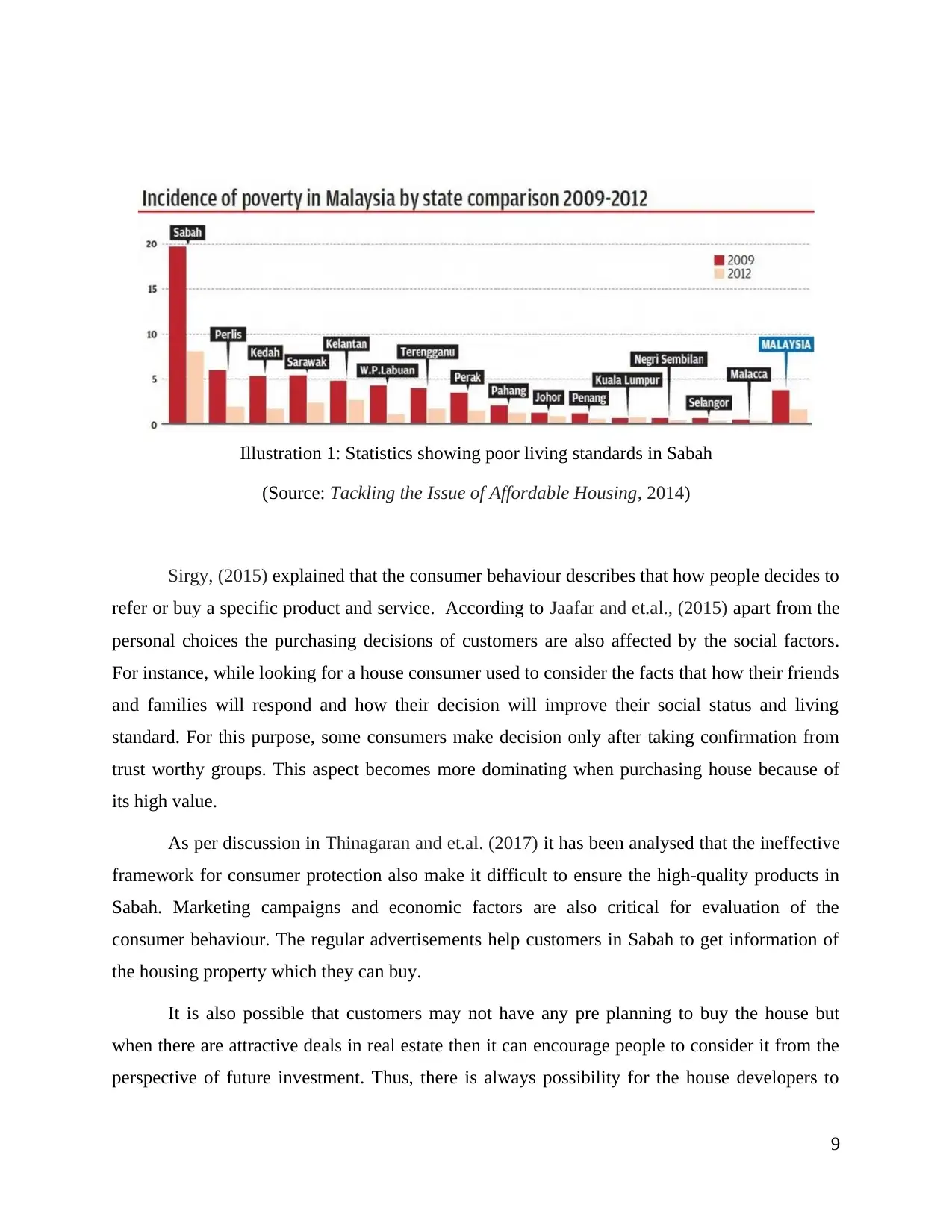
(Source: Tackling the Issue of Affordable Housing, 2014)
Sirgy, (2015) explained that the consumer behaviour describes that how people decides to
refer or buy a specific product and service. According to Jaafar and et.al., (2015) apart from the
personal choices the purchasing decisions of customers are also affected by the social factors.
For instance, while looking for a house consumer used to consider the facts that how their friends
and families will respond and how their decision will improve their social status and living
standard. For this purpose, some consumers make decision only after taking confirmation from
trust worthy groups. This aspect becomes more dominating when purchasing house because of
its high value.
As per discussion in Thinagaran and et.al. (2017) it has been analysed that the ineffective
framework for consumer protection also make it difficult to ensure the high-quality products in
Sabah. Marketing campaigns and economic factors are also critical for evaluation of the
consumer behaviour. The regular advertisements help customers in Sabah to get information of
the housing property which they can buy.
It is also possible that customers may not have any pre planning to buy the house but
when there are attractive deals in real estate then it can encourage people to consider it from the
perspective of future investment. Thus, there is always possibility for the house developers to
9
Illustration 1: Statistics showing poor living standards in Sabah
Sirgy, (2015) explained that the consumer behaviour describes that how people decides to
refer or buy a specific product and service. According to Jaafar and et.al., (2015) apart from the
personal choices the purchasing decisions of customers are also affected by the social factors.
For instance, while looking for a house consumer used to consider the facts that how their friends
and families will respond and how their decision will improve their social status and living
standard. For this purpose, some consumers make decision only after taking confirmation from
trust worthy groups. This aspect becomes more dominating when purchasing house because of
its high value.
As per discussion in Thinagaran and et.al. (2017) it has been analysed that the ineffective
framework for consumer protection also make it difficult to ensure the high-quality products in
Sabah. Marketing campaigns and economic factors are also critical for evaluation of the
consumer behaviour. The regular advertisements help customers in Sabah to get information of
the housing property which they can buy.
It is also possible that customers may not have any pre planning to buy the house but
when there are attractive deals in real estate then it can encourage people to consider it from the
perspective of future investment. Thus, there is always possibility for the house developers to
9
Illustration 1: Statistics showing poor living standards in Sabah
⊘ This is a preview!⊘
Do you want full access?
Subscribe today to unlock all pages.

Trusted by 1+ million students worldwide
1 out of 44